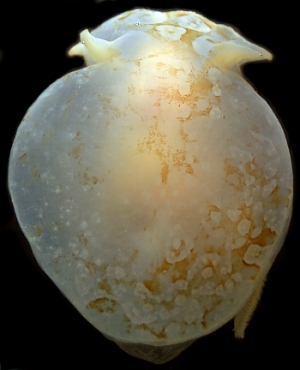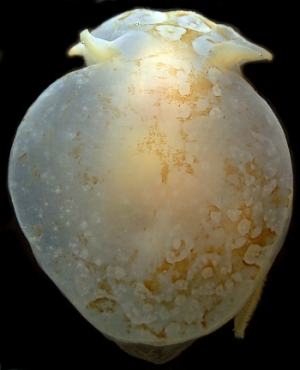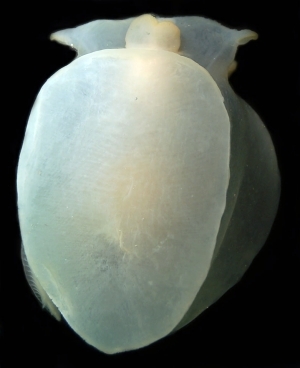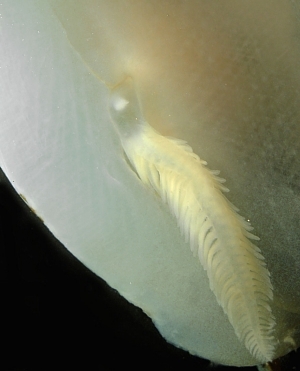
Gigantonotum album
Lin Guangyu & Tchang Si, 1965
Order: NOTASPIDEA
Superfamily: PLEUROBRANCHOIDEA
Family: Pleurobranchidae
DISTRIBUTION
Known only from deep water in the South China Sea
PHOTO
Locality: near Atoll Da Lat , depth from 329 to 428 m, Vietnam, Pacific Ocean, South China Sea, 31 May 2007, dredged. Length: 8 cm. Photographer: A. V. Chernyshev.
Gigantonotum album Lin Guangyu & Tchang Si, 1965 was named from a specimen collected south of Hainan Island in 220 m. It is characterised by the broad mantle which covers the foot and the gill. I assume the name album is based on the whitish colour of the holotype, but since it was in preservative when described, its colour would better be described as translucent with brown mottling, as in the Alexei Chernyshev's photograph. Willan (1977) synonymised Gigantonotum with Pleurobranchella, a genus erected by Thiele (1925) for a species from the Nicobar Islands, P. nicobarica. However Marcus & Gosliner (1984) report that Pleurobranchella nicobarica lacks a central radular tooth while G. album has one. The anatomy of Gigantonotum needs to be re-examined before the suggested synonymy can be confirmed [see message #20358 ].
-
Guangyu, L. & Tchang Si. (1965) Etude sur les mollusques Pleurobranchidae de la cote de Chine. Oceanologia et Limnologia Sinica, 7(3): 265-277
-
Marcus, E. and Gosliner, T. M. (1984) Review of the family Pleurobranchaeidae (Mollusca, Opisthobranchia). Annals of the South African Museum 93: 1-52,Figs1-25.
-
Thiele, J. (1925) Gastropoda der Deutschen Tiefsee Expedition. II Teil. Wissenschaftliche ergebnisse der Deutschen Tiefsee-expedition auf dem Dampfer “Valdivia” 1898-1899, 17(2): 38-382, pls. 13-46.
-
Willan, R. C. (1987) Phylogenetic systematics of the Notaspidea (Opisthobranchia) with reappraisal of families and genera. American Malacological Union Bulletin, 5: 215-241.
Rudman, W.B., 2007 (July 9) Gigantonotum album Lin Guangyu & Tchang Si, 1965 . [In] Sea Slug Forum. Australian Museum, Sydney. Available from http://www.seaslugforum.net/find/gigaalbu
Related messages
Re: Gigantonotum album from South China Sea
August 2, 2007
From: Bill Rudman
Concerning message #20146:
When discussing Gigantonotum album I should have mentioned Inoue & Okutani (1987) which described specimens of what appears to be the same animal from Suruga Bay on the Pacific side of Honshu, Japan. They have identified their specimens as Pleurobranchella nicobarica Thiele, 1925 and describe its internal anatomy which conforms with what is known from the original description. As I mentioned before, little is known of the anatomy of Gigantonotum except for the radula which is reported to have a central radula tooth - absent in Pleurobranchella. Because the external shape of Gigantonotum and Pleurobranchella is so similar, it seems likely that the report of the central tooth in Gigantonotum was an error but it would be nice if Alexei Chernyshev's specimen could be checked because of it was found closest to the type of Gigantonotum.
If we accept Inoue & Okutani's identification, Pleurobranchella nicobarica will have a wide distribution from Japan, west to South Africa [as Pleurobranchoides gilchristi O'Donoghue, 1929, and the Red Sea [as Pleurobranchoides sp. Eales, 1938]. In Japan it has been found at depths of between 200-400 m, and has a soft gelatinous translucent body when alive. It is found quite commonly by fisherman operating crab trawlers.
-
Inoue, R. and Okutani, T. (1987) Pleurobranchella nicobarica Thiele, 1925, new to the Japanese Notaspidea fauna. Venus, The Japanese Journal of Malacology 46: 219-225.
Best wishes
Bill Rudman
Gigantonotum album from South China Sea
July 7, 2007
From: Alexei Chernyshev

Dear Bill,
This notaspids was collected by bottom trawl in south part of South China Sea (8°41' N; 111°42' E). This specimen is similar to Pleurobranchaea maculata, but it has poorly developed pigmentation and very soft translucent body.
Locality: near atoll Da Lat , depth from 329 to 428 m, Vietnam, Pacific Ocean, South China Sea, 31 May 2007, dredged. Length: 8 cm. Photographer: A. V. Chernyshev.
Yours sincerely,
Alexei
tsher@bio.dvgu.ru


Dear Alexei,
If I have identified you animal correctly this is a very interesting find. As soon as I saw your photo I thought Gigantonotum album. And why on earth would I remember such a thing? .. well my wife says its because I am very strange - but in this case its because I have been preparing a few pleurobranch pages for the Forum and this is a problem genus, related to Pleurobranchaea, which still needs to be sorted out.
Gigantonotum album Lin Guangyu & Tchang Si, 1965 was named from a specimen collected south of Hainan Island in 220 m, which is not far from where you found yours. It is characterised by the broad mantle which covers the foot and the gill. Willan (1977) synonymised Gigantonotum with Pleurobranchella, a genus erected by Thiele (1925) for a species from the Nicobar Islands, P. nicobarica. However Marcus & Gosliner (1984) report that Pleurobranchella nicobarica lacks a central radular tooth while G. album has one, so the proposed synonymy remains tentative. The anatomy of Gigantonotum is therefore in need of further investigation so I suspect your specimen will be in demand, or if you plan to dissect it yourself, your findings will be of great interest.
-
Guangyu, L. & Tchang Si. (1965) Etude sur les mollusques Pleurobranchidae de la cote de Chine. Oceanologia et Limnologia Sinica, 7(3): 265-277
-
Marcus, E. and Gosliner, T. M. (1984) Review of the family Pleurobranchaeidae (Mollusca, Opisthobranchia). Annals of the South African Museum 93: 1-52,Figs1-25.
-
Thiele, J. (1925) Gastropoda der Deutschen Tiefsee Expedition. II Teil. Wissenschaftliche ergebnisse der Deutschen Tiefsee-expedition auf dem Dampfer “Valdivia” 1898-1899, 17(2): 38-382, pls. 13-46.
-
Willan, R. C. (1987) Phylogenetic systematics of the Notaspidea (Opisthobranchia) with reappraisal of families and genera. American Malacological Union Bulletin, 5: 215-241.
Best wishes,
Bill Rudman
